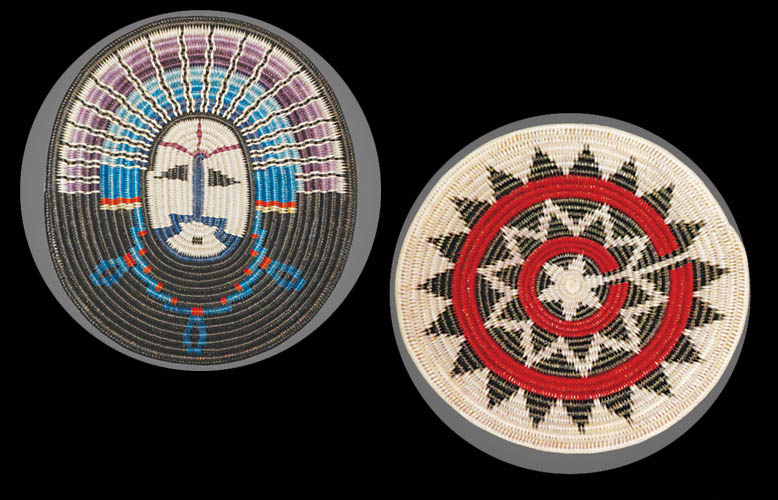John Wayne’s iconic Westerns Stagecoach and The Searchers were filmed along the Arizona and Utah border in Monument Valley, a breathtaking expanse of sheer walled red rock mesas, buttes, and spires.
Here, Forrest Gump ceased his cross-country run and Clint Eastwood climbed a spire known as Totem Pole for the film The Eiger Sanction.
Timeless formations—Right and Left Mitten, Three Sisters, Elephant Butte, North Window—rise up from the stark surrounding earth so dramatically that Hollywood regularly returns. This area lies within the Homelands of the Navajo (Dine`) People who have lived here 500 years and in 1964 made Monument Valley the largest Tribal Park in the United States.
It also happens to be the home of some of the greatest contemporary Native American basket weavers.
Those aware of American Indian basketry might think of vintage Apache, Hopi or Papago works of the Southwest or antique baskets of California Tribes—Pomo, Washoe and Paiute. Many collectors view these as ‘the classics’ of Native American basketry.
Yet, the adage—Tradition is not still, like a stagnant pond. It is alive and moving, passing from one generation to the next, like a flowing stream.—is sometimes better understood by Native American Peoples and artists than it is by Native American scholars and art collectors.
For instance, Navajo rugs, jewelry and baskets made 50 or 100 years ago, prevalent in museums and Native American Antique Galleries, need to be regarded as representing people of a former time. When those works were being made, however, many were considered to be contemporary, even cutting edge.
Navajo Ceremonial Baskets have long served as items representing sacredness. Once a basket of this type has been used in a ceremony, it tends to remain within the extended family. By 1960, as had occurred in a number of other tribes, the making of new baskets was declining, only 10 -15 Navajo weavers were active.
At this time, a young Navajo woman, Mary Holiday Black, began weaving. Mary would became so accomplished she helped revive the craft while elevating it to a well-respected level of art.
Fortuitously, Twin Rocks Trading Post, just 50 miles down the road in Bluff, Utah, opened in the mid ’80s. The Simpson brothers recognized her talent and became renowned patrons for and traders of Mary Black’s works, encouraging and financing the innovative styles that define contemporary Native American basketry.
Today, Mary seldom weaves and her next generation of daughters and daughters-in -law—Lorraine Black, Elsie Holiday, Sally Black, Peggy Black, Agnes Gray—have continued her legacy. It is as if the baskets are now canvasses upon which these weavers have ‘painted.’ The difficulty arises from the palette, consisting of sumac and the image being made at the very same moment. The works that these weavers endeavor to produce have elevated basketry from a utilitarian craftwork to an artisan medium. They are as gorgeous and inspiring as the surrounding landscape from which they come.
182 E Hood Avenue, Sisters
Hours: 10-5pm Thursday-Saturday
Sunday 11-4 pm, Monday 11-4pm
541-719-1182
www.ravenmakesgallery.com

